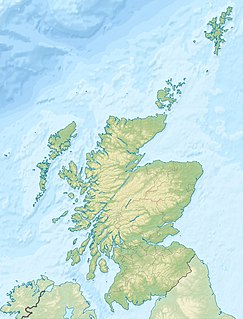
The Moray Firth is a roughly triangular inlet of the North Sea, north and east of Inverness, which is in the Highland council area of north of Scotland. It is the largest firth in Scotland, stretching from Duncansby Head in the north, in the Highland council area, and Fraserburgh in the east, in the Aberdeenshire council area, to Inverness and the Beauly Firth in the west. Therefore, three council areas have Moray Firth coastline: Highland to the west and north of the Moray Firth and Highland, Moray and Aberdeenshire to the south. The firth has more than 800 kilometres of coastline, much of which is cliff.

Moray, or Elginshire, is a historic county, registration county and lieutenancy area of Scotland, bordering Nairnshire to the west, Inverness-shire to the south, and Banffshire to the east. It was a local government county, with Elgin the county town, until 1975. Before 1889 there were two large exclaves of Moray situated within Inverness-shire, and an exclave of Inverness-shire situated within Moray. The Local Government (Scotland) Act 1889 transferred these exclaves to the counties which surrounded them. The county was officially called Elginshire, sharing the name of the Elginshire parliamentary constituency, so named since 1708. The area became known as Moray after 1930 in official documents, but the term "Morayshire" was introduced in handwritten ledgers as there were problems in distinguishing Moray from Norway and Morar.

Fetterangus is a small village in Aberdeenshire, Scotland, located just to the north of Mintlaw. Fetterangus is often called "Fishie" though the origin of this nickname is unknown.
Craggie Cat is a hill landform in the Mounth of the Grampian Mountains at the southern edge of Netherley, Aberdeenshire, Scotland. The peak elevation of Craggie Cat is 198 metres according to the Ordnance Survey. This hill's southwestern flanks form the northwest boundary of the moorland of Curlethney Hill.

Hatton is a village in Aberdeenshire, Scotland that lies on the A90 road, approximately equidistant from both Ellon and Peterhead.

St Combs is a small fishing village in Aberdeenshire, Scotland immediately southwest of Inverallochy near Fraserburgh which has existed since at least the 17th century. It takes its name from a church to St Colm or Columba that used to exist in the area.
Thornyhive Bay is an embayment along the North Sea coast in Aberdeenshire, Scotland. This bay is situated approximately 2.5 miles south of the town of Stonehaven and approximately 2.5 miles north of the Fowlsheugh Nature Reserve. The steep cliffs afford sightings of certain seabirds.
The Burn of Myrehouse is a coastal stream in Aberdeenshire in northeast Scotland discharging to Banff Bay. This watercourse has been suggested as an associated feature to the prehistoric feature at nearby Longman Hill.

Banff Bay is a coastal embayment in Scotland situated between the towns of Banff, Aberdeenshire and Macduff, Aberdeenshire. The Burn of Myrehouse is one of the streams draining to Banff Bay. Banff Bay is a prominent geographical feature along the northern coast of Aberdeenshire, and it is visible from a number of locations along the coastal plain such as Longman Hill situated somewhat distant to the east.
Longman Hill is a Bronze Age long barrow situated atop a prominent rounded landform in northern Aberdeenshire, Scotland near Banff Bay. Due to the low-lying coastal plain characteristics, the elevation of Longman Hill affords a long-distance view as far as the Moray Firth.
The Foudland Hills is a mountainous landform in the northeast of Aberdeenshire, Scotland and northwest of Morayshire. The Foudland Hills are a prominent feature along the northern coastal region of Aberdeenshire, and are visible from somewhat distant points such as Longman Hill to the east.

Bin of Cullen or Bin Hill is a hill in Moray, Scotland directly inland from Findochty. Bin of Cullen is 320 m in height and visible from considerable distances, such as Longman Hill to the east and Lossiemouth to the West. There was formerly a large cairn at the top of the hill but in 2002 this mysteriously disappeared.
Cairn Lee is a prehistoric monument in Aberdeenshire, Scotland. Cairn Lee and proximate Longman Hill are the oldest prehistoric features in the local area.

Dubford is a small village in northern coastal Aberdeenshire, Scotland. Dubford is situated along the B9031 road approximately 6 kilometres (3.7 mi) east of Macduff, south of Gardenstown. There is evidence of prehistoric man in the vicinity of Dubford, notably from the nearby Longman Hill and Cairn Lee ancient monuments.
Laeca Burn is a stream in northeastern Aberdeenshire, Scotland. There are numerous archaeological sites in the Laeca Burn watershed, "especially on the eastern side of Laeca Burn", where Catto Long Barrow is situated.
Skelmuir Hill is a landform in Aberdeenshire, Scotland. This is the location of a trig point or official government survey marker. Skelmuir Hill is the site of some ancient standing stones; it is in the vicinity of another ancient monument, Catto Long Barrow.
The Hill of Aldie is an elevated landform in the east of Aberdeenshire, Scotland. Nearby is the prehistoric monument Catto Long Barrow.
The South Ugie Water is a tributary of the Ugie Water in northeastern Aberdeenshire, Scotland. To the south of the Ugie Water are a number of prehistoric monuments, evidencing the habitation of early man in the northeast of Scotland; for example, the Catto Long Barrow and a number of tumuli are situated in this locale.
The B9031 Road is a paved public highway in northern Aberdeenshire, Scotland. The roadway is notable for its proximity and access to a number of scenic, historic and prehistoric sites. for example the road provides access to the historic St. Drostan's Kirk. The road also provides proximity access to the prehistoric sites of Cairn Lee and Longman Hill.








